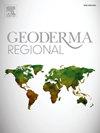Factors governing the formation, distribution and taxonomy of soils with glossic horizons and features in the contiguous USA
IF 3.3
2区 农林科学
Q2 SOIL SCIENCE
引用次数: 0
Abstract
Soils with glossic horizons and features (referred to here as glossic soils) have horizons with interfingering of albic materials in the upper part of an underlying argillic or natric horizon. In the contiguous (exclusive of Alaska and Hawaii and US territories) USA there are 739 soil series covering 227,000 km2 with a glossic horizon or glossic features. Here we analyze site factors and soil properties that govern their formation, distribution and taxonomic classification. Seven distinctive geographic regions containing glossic soils were examined: the Great Lakes (37 % of area), Gulf Slope (23 %), Lower Mississippi Valley (12 %), Central Thin Loess-Till region (9 %), Rocky Mountains (9 %), Northern Great Plains (6 %), and Florida Flatwoods (2 %). Glossic soils in these regions have the following features: 90 % of the soil series are well, moderately well, or somewhat poorly drained, 92 % are covered with broadleaved or mixed broadleaved-coniferous forest, 92 % are deep or very deep (>100 cm), 85 % have mixed or siliceous mineralogy according to Soil Taxonomy (ST), 73 % have a coarse-loamy, fine-loamy, fine-silty, or fine particle size class according to ST, and 70 % of the soils have a base saturation > 70 % in the 0 to 50 cm depth. About 40 % of what was once may have been the argillic or natric horizon has been degraded, but some argillic horizons in the Great Lakes and Lower Mississippi Valley have been completely degraded to depths of >200 cm. Five constructs explaining the origin of glossic horizons are explored, including (i) lithologic discontinuities, (ii) a former periglacial climate and permafrost, (iii) shifts in ecotones related to climate change, (iv) increased podzolization following leaching of carbonates; and (v) redox processes derived from a fluctuating water table. Glossic soils occur on sediments dated from early Holocene to early Pleistocene age, or older. About 38 % of the soil series likely have never experienced permafrost or a periglacial climate. Formation of a glossic horizon or features is a retrograde form of pedogenesis initiated by the loss of carbonates, acidification, and the development of redoximorphic features. This process may be driven by natural stages in pedogenesis or by major changes in early Holocene climate and vegetation. About two-thirds of the glossic soils in the contiguous USA do not meet the requirements of albeluvic glossae or retic properties in the WRB classification system.
美国邻近地区具有光泽层和特征的土壤形成、分布和分类的控制因素
具有光滑层位和特征的土壤(这里称为光滑土)的层位在下面的泥质或天然层位的上部穿插着白色物质。在毗连的美国(不包括阿拉斯加和夏威夷以及美国领土),有739个土壤系列,覆盖227,000平方公里,具有光滑的水平或光滑的特征。本文分析了影响其形成、分布和分类的场地因素和土壤性质。七个独特的地理区域包含有光泽的土壤被检查:五大湖(面积的37%),海湾斜坡(23%),下密西西比河谷(12%),中央薄黄土- till地区(9%),落基山脉(9%),北部大平原(6%)和佛罗里达Flatwoods(2%)。Glossic土壤在这些地区有以下特点:90%的土系好,适度,或排水不良,或混合broadleaved-coniferous阔叶林覆盖着92%,92%是深或很深(在100厘米),85%的混合或硅质根据土壤矿物学分类(ST), 73%有coarse-loamy fine-loamy, fine-silty,或细粒度类根据圣,和70%的土壤已经基本饱和比;70%在0至50厘米深度。曾经可能是泥质层或天然层的大约40%已经退化,但在五大湖和密西西比河下游河谷的一些泥质层已经完全退化到200厘米深。探讨了五种解释光滑层的起源的构造,包括(i)岩性不连续,(ii)前冰缘气候和永久冻土层,(iii)与气候变化相关的过渡带转移,(iv)碳酸盐淋滤后灰化化增加;(v)由波动的地下水位引起的氧化还原过程。在全新世早期至更新世早期或更早的沉积物上发现有光泽的土壤。大约38%的土壤系列可能从未经历过永久冻土或冰缘气候。有光泽的层位或特征的形成是由碳酸盐的丧失、酸化和氧化变质特征的发展所引起的一种逆行的成土作用。这一过程可能是由早期全新世气候和植被的重大变化所驱动的。在美国邻近地区,约有三分之二的光滑土壤不符合WRB分类系统中白舌性或粘性特性的要求。
本文章由计算机程序翻译,如有差异,请以英文原文为准。
求助全文
约1分钟内获得全文
求助全文
来源期刊

Geoderma Regional
Agricultural and Biological Sciences-Soil Science
CiteScore
6.10
自引率
7.30%
发文量
122
审稿时长
76 days
期刊介绍:
Global issues require studies and solutions on national and regional levels. Geoderma Regional focuses on studies that increase understanding and advance our scientific knowledge of soils in all regions of the world. The journal embraces every aspect of soil science and welcomes reviews of regional progress.
 求助内容:
求助内容: 应助结果提醒方式:
应助结果提醒方式:


